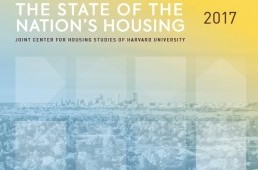
June 23, 2017 | by Michael Wilt
Categories: Affordable Housing, Construction, Homeownership, Rental Housing
The national housing market is finally returning to normal nearly a decade after the foreclosure crisis, but affordability problems persist at near record levels. That's the main takeaway from "The State of the Nation's Housing 2017" report released last Friday by the Joint Center for Housing Studies of Harvard University.
On the upside, new construction was up for the seventh year in a row, but it's still well below the pace of construction from the 80's and 90's. The decline in homeownership is stabilizing, and the number of homeowners facing foreclosure has fallen sharply.
On the downside, the number of cost-burdened households (those that spend more than 30% of their income on housing) remains high at 38.9 million nationally. Even worse, more than 70% of the lowest-income households (earning less than $15,000) are severely cost-burdened (spend more than 50% of their income on rent). Households that are cost-burdened or severely cost-burdened often have to forego other necessities, such as quality food or medical care, to afford their monthly housing costs.
Here's a closer look at key takeaways for Texas:
1. Metro Areas are Adding High-Rent Units and Losing Low-Rent Units
From 2005 to 2015, Dallas added 27,886 units that rent for $2,000 or more while losing 28,073 units that rent for $700 or less. Over that same period, the same held true for Austin (added 12,809 units at $2,000 or more and lost 27,494 at $700 or less), Houston (added 33,118 and lost 8,440) and San Antonio (added 4,744 and lost 1,100).
2. Renters Continue to be Cost-Burdened
In the Houston Metropolitan Statistical Area (MSA), 46.7% of renters are housing cost-burdened, and 24.9% are severely housing cost-burdened. The numbers aren't much better across the state.
3. Median Price Home Remains Out of Reach for Many
The McAllen-Edinburg MSA is the strongest area for homeownership opportunities as 74.4% of households can afford the median price home. The El Paso MSA checks in at 68.5%, followed by the Dallas-Fort Worth MSA at 65.5%, the Houston MSA at 63.7%, and the San Antonio MSA at 63.6%. The Austin MSA is well below the other areas at 59%.
4. Suburbanization of Poverty
Poverty is growing in suburban areas. The number of poor households living in high-poverty tracts in low-density areas more than doubled in the Austin, Dallas-Fort Worth, and Houston MSAs.
For further insight on "The State of the Nation's Housing 2017" report and what it means in Texas, we encourage you to check out this recent article from The Texas Tribune.
On the House blog posts are meant to provide general information on various housing-related issues, research and programs. We are not liable for any errors or inaccuracies in the information provided by blog sources. Furthermore, this blog is not legal advice and should not be used as a substitute for legal advice from a licensed professional attorney.
TSAHC reviews all blog comments before they are posted to ensure a positive experience for our online community. Off-topic comments; hostile, derogatory or deliberately insulting comments; and comments specifically promoting goods and services will not be posted.
Approved comments will be published in their entirety. Personal information will not be removed unless it pertains to someone other than the person submitting the comment. For more information, please see our Comment Posting Guidelines.
To remove a previously submitted and published comment, please contact Anna Orendain at [email protected].
If you have a question regarding any of TSAHC's programs, please contact us.
